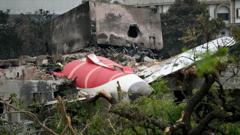Despite the preliminary report from India's Air Accident Investigation Bureau (AAIB) into the tragic Air India Flight 171 crash, many questions linger. The Boeing 787 Dreamliner went down shortly after takeoff from Ahmedabad on its way to London, leading to the loss of 241 lives on board and 19 people on the ground.
The AAIB's report highlights critical moments during the flight, particularly the shifting of fuel cut-off switches just moments after takeoff. This malfunction deprived the engines of fuel and caused a loss of thrust. While it's known the engines were restarted, it was too late to avert the disaster.
Critics within the aviation industry argue that the report is selective in its disclosures, leaving out crucial elements such as pilot exchanges recorded by cockpit voice recorders. They suggest that this lack of transparency invites speculation about the incident, with some alleging potential intentional actions by the crew.
The investigation has drawn ire from the Indian Commercial Pilots' Association, which warns against casually insinuating pilot misconduct amidst ongoing assessments. They have called the media's portrayal of the event irresponsible and disrespectful to the victims' families.
Professional opinions vary, but most agree that the report doesn’t provide a full picture, with missing context on key conversations and actions taken in the cockpit. Additionally, the lack of a verbatim transcript from the voice recorder raises eyebrows.
The report also pointed to a historical safety bulletin concerning Boeing's fuel cut-off switches. While previous concerns about these switches were noted, the FAA suggested they did not directly relate to the crash, complicating the circumstances further.
As the investigation unfolds, with a definitive report expected within a year, many in the industry are concerned that the vague nature of current findings reflects an attempt to obscure real issues surrounding the crash. Until more detailed data is divulged, the mystery behind the cause of Flight 171 will remain a topic of heated discussion.
The AAIB's report highlights critical moments during the flight, particularly the shifting of fuel cut-off switches just moments after takeoff. This malfunction deprived the engines of fuel and caused a loss of thrust. While it's known the engines were restarted, it was too late to avert the disaster.
Critics within the aviation industry argue that the report is selective in its disclosures, leaving out crucial elements such as pilot exchanges recorded by cockpit voice recorders. They suggest that this lack of transparency invites speculation about the incident, with some alleging potential intentional actions by the crew.
The investigation has drawn ire from the Indian Commercial Pilots' Association, which warns against casually insinuating pilot misconduct amidst ongoing assessments. They have called the media's portrayal of the event irresponsible and disrespectful to the victims' families.
Professional opinions vary, but most agree that the report doesn’t provide a full picture, with missing context on key conversations and actions taken in the cockpit. Additionally, the lack of a verbatim transcript from the voice recorder raises eyebrows.
The report also pointed to a historical safety bulletin concerning Boeing's fuel cut-off switches. While previous concerns about these switches were noted, the FAA suggested they did not directly relate to the crash, complicating the circumstances further.
As the investigation unfolds, with a definitive report expected within a year, many in the industry are concerned that the vague nature of current findings reflects an attempt to obscure real issues surrounding the crash. Until more detailed data is divulged, the mystery behind the cause of Flight 171 will remain a topic of heated discussion.



















